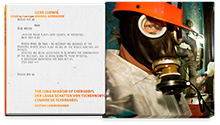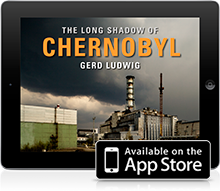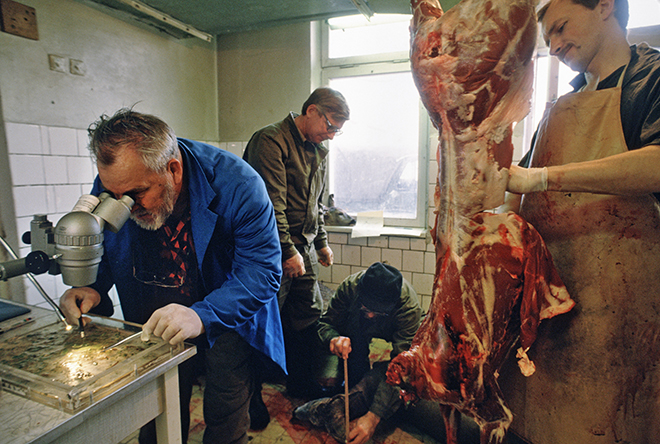 31 years ago on April 26, 1986 at 1:23 am, the Chernobyl Nuclear Power Plant blew up after operators botched a safety test, triggering an explosion and a fire that burned for 10 days.
31 years ago on April 26, 1986 at 1:23 am, the Chernobyl Nuclear Power Plant blew up after operators botched a safety test, triggering an explosion and a fire that burned for 10 days.
Recently, several European media outlets reported that one third of all wild boars hunted in countries in the path of the nuclear fallout (such as the Czech Republic and Germany) still contain such high levels of radiation (Cesium-137) that their meat is not save for consumption. Read more here
During my first visit to the Chernobyl Exclusion Zone, in the early 1990’s, I photographed scientists from the Department of Ecological Botany at the Swedish University in Uppsala as they worked on a study of tissue radioactivity in animals in the Chernobyl Zone. Their research concentrated on the area’s wild boar and roe deer. After the animals’ dissection, then performed in a makeshift lab in a former kindergarten kitchen, their stomach contents were analyzed (photograph above).
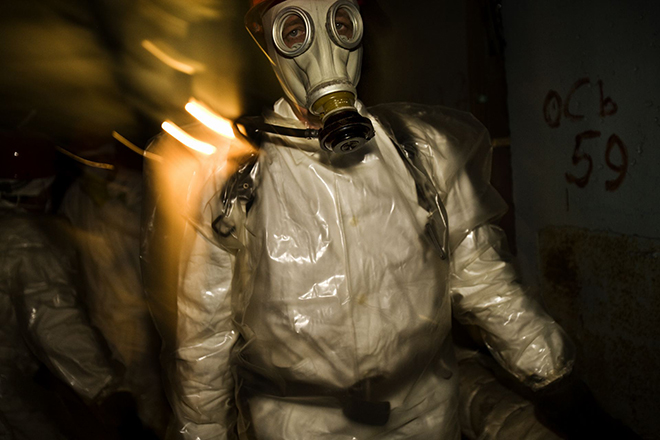
The British news publication ‘The Independent’ recently reported that the robots sent into Fukushima for cleanup are “dying†at a rate five times higher than expected. Although designed to survive in highly contaminated areas, large amounts of radioactive material are eating away at the robots wiring – rendering them useless. Read the full article here.
Six years ago, on March 11, 2011, Japan was hit by one of the most severe earthquakes in recorded history. In the subsequent tsunami, the Fukushima Daiichi Nuclear Power Plant suffered serious damage that led to several meltdowns in the nuclear reactor releasing large amounts of radioactive materials. It was the largest nuclear accident since Chernobyl.
“The news of the robots’ malfunction reminded me of the several times I went into the ill-fated Chernobyl reactor – deeper than any Western still photographer. I had described the harrowing experience in a Proof post on National Geographic a couple of years ago,” says Gerd Ludwig.
See the full Proof post here.
His 20 years covering the aftermath of the Chernobyl catastrophe resulted in the book and iPad App “The Long Shadow of Chernobyl”. The app is available from the iTunes store, see it here.
To order a signed copy of his award-winning book, “The Long Shadow of Chernobyl,” click here.
You can also follow Gerd on IG @gerdludwig, where he quite frequently publishes images from his forays into Chernobyl.
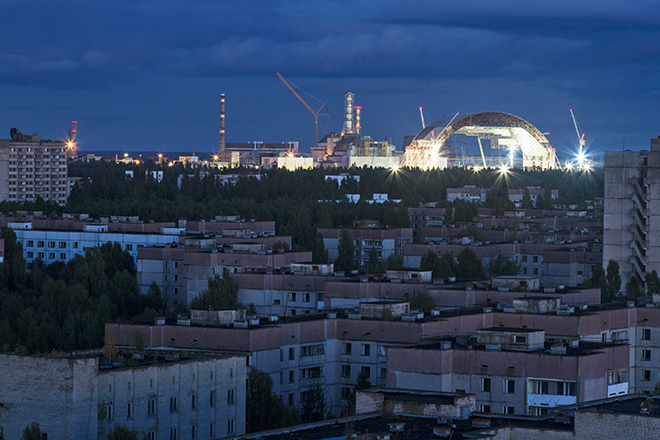
More than 30 years after Chernobyl reactor #4 blew up, causing the world’s worst nuclear disaster to date, the failed power plant is quickly disappearing from sight. A few days ago, workers began moving a new giant shield to cover reactor #4 along with the so-called sarcophagus, a hastily erected steel and concrete structure that was meant to seal in the smoldering radioactive remnants but is now structurally unsound and leaky. Chernobyl’s new shield, named the New Safe Confinement (NSC), is the largest moveable land-based structure ever built.
Spanning 257 meters, the arch-shaped NSC measures 108 meters high and 162 meters long and is strong enough to withstand a tornado. A sophisticated ventilation system was designed to eliminate the risk of corrosion, ensuring that there will be no need to replace the coating and expose workers to radiation during the structure’s lifetime (an estimated 100 years). The final construction cost amounts to 1.6 billion USD, paid for by more than 40 donor countries.
The NSC is currently being slid into its final “resting place” over the leaky sarcophagus. Moving the 36,000-ton structure is accomplished with the help of a special skidding system, consisting of 224 hydraulic jacks that push the arch 60 centimeters each stroke. It is anticipated that the total skid time will be around 40 hours of operation, spread over a period of several days. My photograph shows the arch in the mid-phase of construction.
You can learn more about the Chernobyl catastrophe from my book and iPad app, which resulted from decades of covering the aftermath of the disaster: “The Long Shadow of Chernobyl,†available here.
For more information: Time Magazine – BBC News – European Bank for Reconstruction and Development
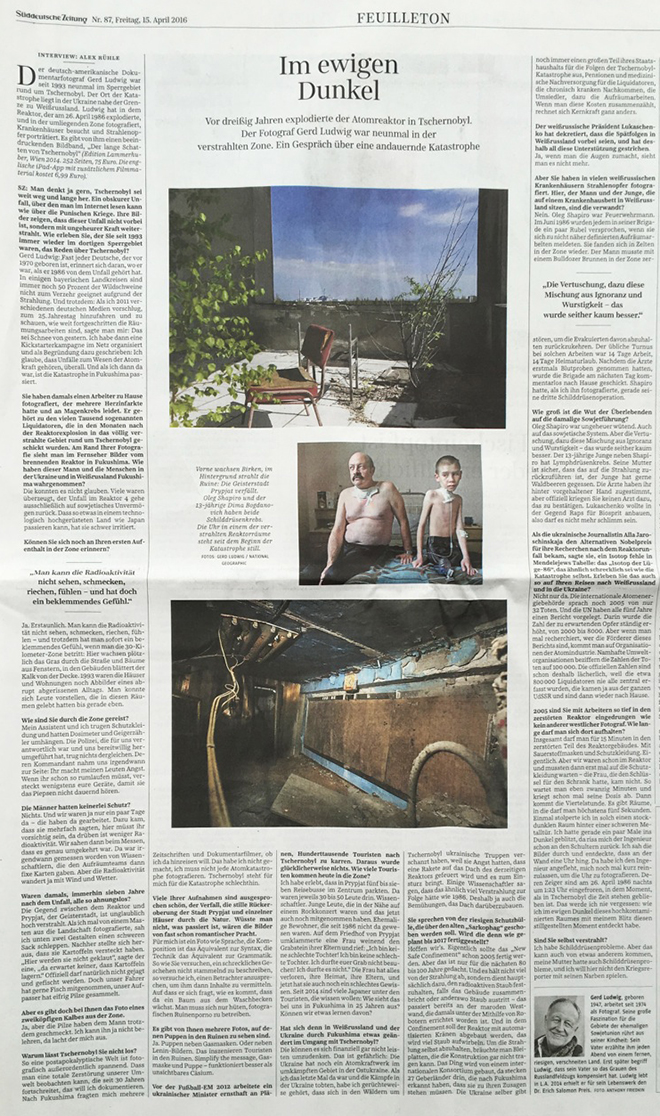
Germany’s Süddeutsche Zeitung published a comprehensive interview with Gerd Ludwig about his work documenting the aftermath of the Chernobyl nuclear disaster.
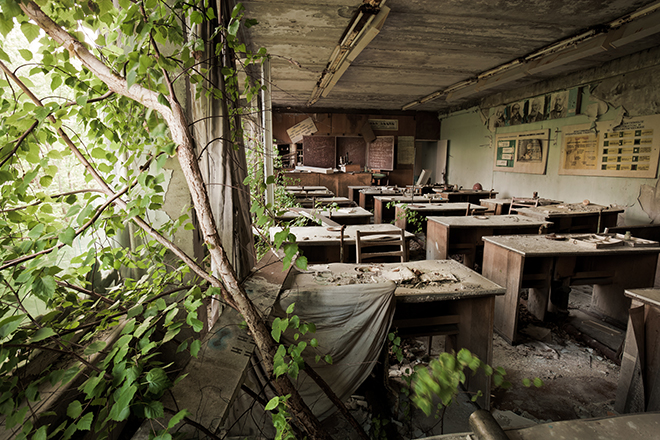
Gerd Ludwig’s Fall Update includes the latest news about The Long Shadow of Chernobyl, including a recent award, and other upcoming events and exhibitions.
See the full newsletter here: http://eepurl.com/bzdOXz

Belarusian author Svetlana Alexievich was announced as the 2015 Nobel Laureate in Literature today. Alexievich is known for her writings on Chernobyl specifically, and excerpts from her book Voices from Chernobyl were published in Gerd Ludwig’s The Long Shadow of Chernobyl. Her writings stem from hundreds of interviews, and the collection of oral history and recorded conversations are integral to her work.
For more information: http://www.cnn.com/2015/10/08/arts/nobel-literature/
 31 years ago on April 26, 1986 at 1:23 am, the Chernobyl Nuclear Power Plant blew up after operators botched a safety test, triggering an explosion and a fire that burned for 10 days.
31 years ago on April 26, 1986 at 1:23 am, the Chernobyl Nuclear Power Plant blew up after operators botched a safety test, triggering an explosion and a fire that burned for 10 days.





